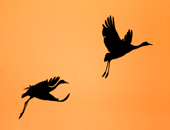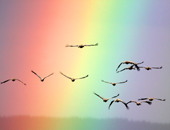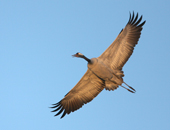Species List | Trip Reports | Home fssbirding.org.uk
Hornborgasjön
Sweden



14 - 19 April 2008
Observers: F. Simpson
|
|
Species List | Trip Reports | Home fssbirding.org.uk |
|
Hornborgasjön Sweden
|
|
|
14 - 19 April 2008 |
|
|
Observers: F. Simpson |
|
INTRODUCTION
This was my first trip abroad with the prime intention of bird photography rather than the usual dash around trying to see all of the specialities in a particular country or area. In fact, this trip was to concentrate on just one species; the Common Crane (or Eurasian Crane as I prefer). During a continued run of poor weather in the winter of 2007, I began thinking of getting away to photograph something more interesting than Coots in the park! As a vague recollection of reading of the spring passage of dancing Cranes in Sweden combined with long lasting mental images of Cranes flying over the Pyrenees in 2004, I began to investigate the opportunity of hiring a photography hide at Hornborgasjön (Lake Hornborga) in southern Sweden. Within a few clicks on the internet I had found the contact address for booking a hide at Hornborgasjön through the Falköping tourist information website. This report details the practicalities of arranging the trip, observations of the Cranes, and other bird species noted in the area.
|
HIGHLIGHTS
Garganey · Bittern · Red-necked Grebe · Slavonian Grebe · Black-necked Grebe · White-tailed Eagle · Marsh Harrier · Goshawk · Osprey · Eurasian Crane · Crested Tit · Common Redpoll
|
| CRANES
Background In Western Europe, Cranes are long distance migrants that winter in Iberia and France, moving north to Germany before crossing the Baltic Sea into Scandinavia in spring. Long term monogamous pairs breed on bogs, mires and forest clearings mainly in the Boreal zone. Hornborgasjön is a special place where thousands of Cranes rest briefly over a three week period from late March to mid April. The Cranes resting here are known to nest in Norway and northern Sweden.
Location Hornborgasjön is a large lake in south-west Sweden located in the province of Västergötland. It is less than 10 km north of the town of Falköping, south-east of Skara and south-west of Skövde. It is around a two hour drive east of Gothenberg City Airport. The Trandansen Naturum (Crane dancing nature centre) is in the south at Bjurum and offers fantastic opportunities to view the dawn and dusk flights of the Cranes which come to feed and display each day. The photography hides for hire are located out on the reserve in the thick of the action and are accessed at night after the birds have left for the safe refuge of their nightly roost site.
Timing I had been carefully following the movements of Cranes through the Grus grus Yahoo e-mail group and it soon became clear in the middle of March that the birds were advancing north much earlier than in most years. The first 170 birds arrived at Hornborgasjön on 10 March. Numbers remained low for around 10 days until 2230 were present on the 22nd, 7660 on the 26th, and 12200 on the 30th. Ideally I would like to have gone in the first week of April but due to work commitments I had to opt for the first available dates of 15 and 16 April. Would all the Cranes have departed by the time I arrived? Using the data provided from 1994 to 2007 on the Crane Statistics pages on the Hornborga website I had hoped on around 3-4000 birds still being present on my arrival. Numbers peaked on 3 April with an incredible 15300 birds. Numbers held up throughout the week and I began to relax. I had a backup plan do some birding in southern Sweden should the photo hides be a lost opportunity but when I arrived at Trandansen Naturum on the Monday I was happy to see plenty still present and the count of 6700 on the information board. It was tight though. The last count was of 670 birds on the 20th. The phenology of area was probably around a month behind southern England with primroses and coltsfoot flowering but no leaves on the trees. There were some hard frosty mornings though a Swedish photographer told me he experienced -14°C in the hides a few years back!
Photo opportunities The Trandansen Naturum offers excellent opportunities to study and photograph the Cranes which may approach as close as 50 metres away between the visitor centre and the long viewing track all the way to church at Bjurum. The photo hides allow unparalleled opportunities for close ups and a disturbance-free way to capture Crane behaviour as they feed within metres of the hides - sometimes too close! The warden provides you with a bucket of barley which you can spread the evening before outside your hide at desired locations. A large amphibious vehicle also spreads a few tons of barley grain over the reserve each evening. As it passes the hides, the scattering grain sounds like a hail storm from inside the small wooden hut. Other species can be photographed including Whooper Swans, Wigeon and Teal.
|
| LOGISTICS
Flights London Stansted (STN) to Gothenburg City (GSE) with the Irish chav airline cost £85 including baggage, airport check in fee and travel insurance when booked just six weeks before the trip. I also had insurance to cover my equipment.
Baggage With a 40 litre rucksack which met the carry on size requirements, I squeezed in two dslr bodies, 500mm f4, 100-400mm f4-5.6, 1.4X extender, 8x42 binoculars plus other minor accessories. At security in London the whole bag was emptied, searched and swabbed and I had to repack it (again) carefully with bubble wrap. My tripod legs and head were securely packed in the hold luggage.
Ground Transport Car hire with Hertz was £228 for a compact/4-door inclusive of damage excess waiver and unlimited mileage.
Hide Rental In 2008 the photo hides were SEK 650 (£55) per day which had to be paid in advance by telegraphic transfer from my bank to the tourist office in Fälkoping (info@falkoping.nu +46 51577 70 50). The greedy bank charged £19.50 for the transfer! I had to laugh when the assistant commented that it seemed expensive to hire a hide. And £19.50 for tapping a few buttons is value for money? A Rental Agreement must also be signed and returned. Visitors need to be in the hide one hour before sunrise but you can also enter the previous evening after the Cranes have left to roost (after 2000h) and sleep overnight. Latrine facilities are provided but you need to bring everything else such as sleeping bag, stool, food, etc. I put my new Swedish Walkstool to good use. The hide rental cost includes car parking at the Trandansen visitor centre though this is just SEK 20 per day.
Accommodation Hotell Stadskällaren in Skara (www.hotellstadskallaren.se) SEK 400-800 (£34-68) for a single room inclusive of breakfast. Otherwise, overnight in the photo hides.
Maps Motormännens Sverige Vägatlas (Sweden Road Atlas). Kartcentrum.
Fuel Petrol cost SEK 12.85 per litre of standard unleaded, i.e. much the same as prices in the UK at this time.
Exchange
Rate April 2008 SEK 11.87 = £1.00
|
LITERATURE, REFERENCES & ONLINE RESOURCES
• Lundin,
G. et al. 2005. Cranes - where, when and why? Supplement
2005 no. 43 of Vår Fågelvärld,
• Snow,
D.W. & Perrins, C.M. 1998. The Birds of the Western Palearctic.
Oxford University Press.
• Booking
hides: Fälkoping
Tourist Office web: www.falkoping.nu
email: info@falkoping.nu
• Information
on Lake Hornborga: www.hornborga.com
• Daily
counts of Cranes at Trandansen Naturum, Bjurum:
www.hornborga.com/eng/crane_stat.asp
• Grus-grus
Yahoo E-mail Group: http://uk.groups.yahoo.com/group/grus-grus/
• Wirdheim, A. et al. Birding Southern Sweden. Swedish Ornithology Society.
• Aulén, G. 1996. Where to Watch Birds in Scandinavia. Hamlyn.
• Bain, C. & Cornwallis, G. 2003. Sweden. Lonely Planet.
|
ITINERARY
Day 01 14/04/08 London
> Göteborg > Borås > Ulricehamn > Falköping >
Trandansen Naturum, Bjurum
|
Day
1 GOTHENBURG
CITY AIRPORT, SÄVE GÖTEBURG
> FALKÖPING
TRANDANSEN
NATURUM (CRANE DANCING NATURE CENTRE), BJURUM, HORNBORGASJÖN
(LAKE HORNBORGA) A warden arrived at 1915h as the first groups of Cranes started to leave the feeding area and fly the short distance to the roost site on the main lake. After the last Crane had departed we walked the 500 metres out onto the reserve to the photo hides. A flock of 22 Tree Sparrows were feeding on some spilt barley on the track. On reaching hide number one a Swedish photographer was emerging and preparing to leave and he kindly shared some tips with me. The hide was really a very small wooden hut which was accessed by climbing through a very small door. Although cramped inside it was perfectly adequate with six viewing holes around the four sides. I scattered some grain on the small hillock behind the hide, some at the water edge for the ducks and made some piles very close to the hide itself to attract the Cranes right in. Very soon it was dark and I was inside the sleeping bag reading by head torch.
|
| Day
2
TRANDANSEN, HORNBORGASJÖN
- photo hide #1 The sun rose higher into some thick cloud but by midday this had thinned out bringing some nice sunshine. Fourteen hours to take photographs may seem like a long time but the hours quickly passed away, particularly as I waited for long periods for some dancing activity. Since my visit was towards the end of the resting period of passage birds they were probably getting a bit lazy by this stage, more intent on heading north to the breeding grounds. When a pair did start to display they were often partly obscured by other birds which doesn't make for the best image
.
Dancing Cranes The 'dance' courtship usually begins with some posturing, raising the head and fluffing up the tail plumes. Some head bobbing follows with loud calling, raising of the wings and the start of some short leaps into the air. Paired birds jump together which often encourages neighboring pairs to join in. Occasionally this spreads through the group like a Mexican wave! Single males start to run back and forth, frantically jumping at random Cranes. They often pick up an 'ornament' from the ground, usually a lump of turf, small stick, or feather, throw it into the air and immediately attempt to kick it or hit it with their feet. A later component of the courtship seems to involve pairs trumpeting or calling in unison with the head and neck thrown back over the body with the beak pointing skywards. Periodically this was observed in small groups as well.
Pairs uttering trumpeting calls in unison
Head profiles of adult and immature
Plumage care
The Cranes were agressive to all other approaching species albeit in a defensive way. This included Whooper Swans which were often busy displaying and trumpeting in small groups of their own. When fights erupted between increasingly territorial swans, chases would occur and they would often spook the bathing and drinking Cranes while they raced across the marshes with their heavy black paddle-like feet slapping the water surface. Teal passing in rapid flight would often cause a Crane to lunge out with a half-hearted attempt to snap at the small duck. Territorial Lapwings resulted in the most disputes with dive-bombing plovers having a go at the tall, grey statuesque birds. The Cranes responded by trying to snap at the Lapwing and even jumping up and attempting to kick it!
From 1855h the first Cranes began to prepare for departure to the roost site. The process reminded me of the Whooper Swans at Caerlaverock where each evening they pace down the field away from the feeding pond, then start to run back to gain enough speed for take off and the short flight over to the roosting pond. At Hornborga the Cranes strolled up the small hill behind the hides and on reaching the top would make short runs before lifting up into the air. As some space cleared on the hilltop, more birds moved into position on the avian runway. Before taking to the air, singles or pairs signaled their intent by stretching out the head and neck at an angle of around 45° while leaning forward in a distinctive posture for a few seconds, usually calling, followed by some measured strides of a few feet before taking flight.
Other species noted included Marsh Harrier, Raven, Buzzard, Pintail, Wigeon, Teal, Mallard, Yellow Wagtail, Reed Bunting, Whooper Swan, Mute Swan, Lapwing, Greylag Goose, Canada Goose, Hooded Crow, Grey Heron, Moorhen, Black-headed Gull, Skylark, Common Gull, Lesser Black-backed Gull, Coot and White Wagtail. By 1955h the last Cranes had flown from the feeding area and by 2100h it was almost dark. The warden came again with another bucket of grain and I moved a short distance to another photo hide at the other end of the small hill. After a quite magical day surrounded by Cranes and not another human in sight I fell asleep with their calls echoing in my head and images of Cranes when I closed my eyes. Clearly a case of Cranes on the brain!
|
| Day
3
TRANDANSEN, HORNBORGASJÖN
- photo hide #6
In the early afternoon a light rain shower further north over the main part of Lake Hornborga resulted in an intense rainbow forming. Using the 500mm lens I took a shot of the end of the rainbow just for the colours and managed to cover most of the spectrum. Things then began to get a bit more interesting when something spooked the wildfowl and Cranes. I had the lens still trained on the end of the rainbow, now hoping for some birds to fly into view. It would have been more pleasing to have the birds fly across the field of view but still, I got some nice shots of Wigeon and Cranes flying towards the rainbow.
Hide #6 looked to be better for capturing images of birds flying off the small hill in the evening. Luckily the sky was clear and some nice colours were starting to form around 1930h. I waited until most had departed leaving just a few with some space around them and managed some pleasing images of them taking off towards dusk.
Species noted today: Goosander (passed overhead), Water Rail, Bittern, Marsh Harrier (pr), Whooper Swan (70+), Wigeon (600+), Teal (200+), Raven (4), Pintail, Gadwall, Mallard, Snipe, Lapwing, White Wagtail, Mute Swan, Grey Heron, Canada Goose, Greylag Goose, Buzzard, Jackdaw, Magpie, Wood Pigeon, Hooded Crow, Coot, Moorhen, Black-headed Gull, Starling, Reed Bunting, Skylark, Meadow Pipit, and Common Gull.
|
| Day
4
Headed north today in the hope of seeing some forest species such as Nutcracker and the scarcer woodpeckers. Maybe I had forgotten my last experience of trying find birds in Swedish forests and today was no different. Best birds were Crested Tit and Common Crossbill. I guess you really need to know the best locations in advance, preferably from a local birder with inside knowledge. It was nice to see large numbers of Brimstones though - another sign of spring.
DRIVE
FROM SKOVDE TO TIVEDEN NATIONAL PARK
TIVEDEN
NATIONAL PARK
Bocksjö - hamlet near junction with main road: Crane, Mistle Thrush (pr), Wood Pigeon, Goldeneye (f) on tiny pond, Greenfinch, Starling (3 prs), Hooded Crow, Fieldfare (2), Mallard (pr), White Wagtail (2), Chaffinch, Magpie
DRIVE
FROM TIVEDEN TO SKOVDE
HORNBORGA
NATURUM, HORNBORGASJÖN (LAKE HORNBORGA)
EKORNAVALLEN,
HORNBORGASJÖN
TRANDANSEN
NATURUM, HORNBORGASJÖN
|
| Day
5
TRANDANSEN
NATURUM, HORNBORGASJÖN Species noted: Marsh Harrier, Eurasian Crane, Redshank, Raven, Whooper Swan, Wigeon, Teal, White Wagtail, Hooded Crow, Lapwing, Jackdaw, Greylag Goose, Canada Goose, Grey Heron, Meadow Pipit, Coot, Cormorant, Moorhen, Tree Sparrow, Chaffinch, Lesser Black-backed Gull, Wood Pigeon, Mallard, Pintail, Kestrel, Mistle Thrush, Black-headed Gull
FÄHOLMEN,
HORNBORGASJÖN
BRODDETORP,
HORNBORGASJÖN
YTTERBERG
HORNBORGASJÖN Crane (overhead), Redshank displaying, Snipe displaying, Lapwing displaying, Shoveler (pr), Reed Bunting (3 singing mm), Goldeneye, Tufted Duck, Great Crested Grebe, Raven, Curlew displaying, Skylark singing, Meadow Pipit (4), Mute Swan, Coot, Greylag Goose, Canada Goose (inc hybrid), White Wagtail, Black-headed Gull, Cormorant, Teal, Starling, and Grey Heron.
Took the trail towards Hornborga Naturum (signposted Kalvamyren 0.7) which starts on a boardwalk across a marsh towards flooded birch woodland. Osprey hovering over a nearby marsh, Yellowhammer (pr), Buzzard (2 soaring), Snipe, Song Thrush (2 singing mm), Wood Pigeon (10+), Blackbird, Wren singing, Blue Tit, Chaffinch, Greenfinch, Robin, and Common Gull.
On the track back towards the main road a flock of 210 Wood Pigeons and 140 Jackdaws were picking over some stubble fields.
TRANDANSEN
NATURUM, HORNBORGASJÖN
|
| Day
6
TRANDANSEN
NATURUM, HORNBORGASJÖN
|
| SPECIES LIST - HORNBORGASJÖN, SWEDEN 14-19 April 2008 To follow...
|
|
All photographs © 2008 F. S. Simpson Fraser's Birding Website · fssbirding.org.uk |